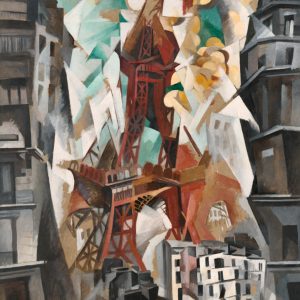Robert Delaunay

Summary
Robert Delaunay was a central figure in the Parisian avant-garde of the early 20th century, known for his innovative use of color and abstract form. Alongside his wife, Sonia Delaunay, he founded Orphism, a movement distinguished by its vibrant color harmonies, faceted compositions, and celebration of modern life. His paintings drew inspiration from the technological marvels and cultural vitality of Belle Époque Paris, including the Eiffel Tower, aviation, and electric lighting. While his reputation fluctuated over the decades, Delaunay’s role in advancing abstraction and his influence on artists across Europe and beyond remain significant.
Childhood and Early Training
Robert Delaunay was born in Paris to George Delaunay and Berthe Félicie de Rose. His parents, from affluent but unconventional backgrounds, separated when he was four. Raised primarily by his aunt and uncle at their estate in La Ronchère near Bourges, he grew up in comfort but without the stability of a traditional family life.
A lackluster student, Delaunay showed little interest in academic studies but demonstrated an early affinity for painting, often sketching during class. At the urging of his uncle, he apprenticed at Ronsin’s Atelier in Belleville, learning theatrical set design. This experience with large-scale decoration would later inform his murals and stage designs.
In 1903, Delaunay traveled to Brittany, where he encountered Henri Rousseau and began painting seriously. Returning to Paris, he befriended Jean Metzinger, and together they experimented with Divisionist techniques inspired by Georges Seurat. Delaunay’s mosaic-like paintings from this period drew early critical attention.
Marriage to Sonia Terk and Early Career
In 1909, Delaunay met Sonia Terk, a Russian émigré artist, then married to art dealer Wilhelm Uhde. The two began a relationship, and after Terk’s amicable divorce, they married in 1910. Sonia became both creative partner and primary financial support for much of their marriage.
Living on Rue des Grands-Augustins, near Pablo Picasso, the couple immersed themselves in Paris’s thriving artistic scene. They painted side by side, drawing inspiration from electric lights, shopfronts, and the dynamism of city life. This shared creative energy led to the development of Orphism, a style of vibrant abstraction rooted in color and rhythm.
Mature Period
In pre–World War I Paris, Delaunay participated in key exhibitions, including the Salon d’Automne and Salon des Indépendants. His Eiffel Tower series (1909–12) captured the structural dynamism of modern architecture in fractured planes of color. His fascination with pure color led to works like the Windows series, which moved toward non-objective abstraction.
Critic Guillaume Apollinaire championed his work, coining the term “Orphism” to describe the lyrical, color-driven abstraction of Delaunay, Sonia, and František Kupka. While Delaunay preferred the term “simultaneity” to describe his art, Orphism secured his place among the pioneers of abstraction.
The couple hosted salons frequented by Henri Rousseau, Fernand Léger, Albert Gleizes, Blaise Cendrars, and Apollinaire. Their social circle reflected the energy of the avant-garde, and their artistic practice embraced modern technology, speed, and motion—seen in works like Hommage à Blériot (1914).
At the outbreak of World War I, the Delaunays relocated first to Portugal, then to Spain. Financially supported by Sonia’s work in fashion and decorative arts, Robert continued painting and worked with Sergei Diaghilev’s Ballets Russes on stage designs.
Return to Paris and Later Career
After the war, the Delaunays returned to Paris in 1920. Sonia’s success as a fashion designer supported the family, while Robert continued to experiment with color and abstraction. The couple revived their salons, now attracting younger artists and writers such as Tristan Tzara, Francis Picabia, and André Breton.
In the 1920s and early 1930s, Delaunay alternated between abstraction and figuration. His large decorative projects, including murals for the 1937 Exposition Internationale in Paris, demonstrated his enduring interest in monumental public art. His aviation and railway pavilions reflected his ongoing fascination with technology and movement.
Late Years and Death
By the late 1930s, Delaunay’s reputation had diminished in comparison to the rising prominence of other modernists. Nonetheless, the 1937 Exposition restored some recognition, though his contributions were overshadowed by Picasso’s Guernica.
With the outbreak of World War II, the Delaunays fled Paris for the south of France. Robert’s health declined, and he died of cancer in Montpellier in 1941. Sonia survived him by three decades, devoting herself to preserving his legacy.
Legacy
Delaunay’s contributions to modern art lie in his groundbreaking approach to color, abstraction, and the celebration of modern life. His theories of simultaneity influenced contemporaries and later artists, including the Blaue Reiter group, Italian Futurists, and American Synchronists. His Windows series in particular anticipated key developments in abstract art.
Sonia’s tireless promotion of his work after his death ensured his place in art history. Her donation of over a hundred of his works to the Musée d’Art Moderne de Paris in 1963 secured a permanent public legacy. Today, Robert Delaunay’s paintings remain central to discussions of the early 20th-century avant-garde, his Orphic compositions embodying the optimism and innovation of modernism.
Mostrando el único resultado
-

Champs de Mars:The Red Tower
$316.00 – $828.00Price range: $316.00 through $828.00 Seleccionar opciones Este producto tiene múltiples variantes. Las opciones se pueden elegir en la página de producto
